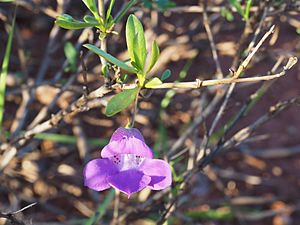Eremophila lanceolata facts for kids
Quick facts for kids Eremophila lanceolata |
|
|---|---|
 |
|
| Eremophila lanceolata leaves and flowers | |
| Scientific classification | |
| Genus: |
Eremophila (plant)
|
| Species: |
lanceolata
|
Eremophila lanceolata is a beautiful flowering plant that belongs to the figwort family, called Scrophulariaceae. This plant is special because it is found only in Western Australia. It grows as a low, spreading bush with shiny leaves when they are young. It has cool, angular branches and its flowers are usually lilac or purple. You can find this plant growing in the north-west parts of Western Australia.
Contents
What it Looks Like
Eremophila lanceolata is a spreading bush that usually grows to be about 15 to 50 centimeters (6 to 20 inches) tall. Its branches are mostly smooth (this is called glabrous) and can be sticky and shiny when they are young because of a natural sticky sap called resin.
The leaves grow one after another along the branches. They are about 1.6 to 4.5 centimeters (0.6 to 1.8 inches) long and 0.25 to 0.65 centimeters (0.1 to 0.25 inches) wide. They are shaped like an oval or a spear (lance-shaped). Just like the branches, the leaves are mostly smooth, sticky, and shiny when they are new. Often, the edges of the leaves have small, clear teeth.
The flowers usually grow one by one where a leaf meets the stem. Each flower sits on an S-shaped stalk that is about 1 to 2 centimeters (0.4 to 0.8 inches) long. There are five green, overlapping, spear-shaped parts called sepals, which are about 0.25 to 0.65 centimeters (0.1 to 0.25 inches) long.
The petals are about 1.1 to 2.4 centimeters (0.4 to 0.9 inches) long and are joined together at the bottom to form a tube. The outside of this petal tube is a deep lilac to purple color, while the inside is white with dark purple spots. The outside of the tube is hairy, but the inside tips of the petals are smooth. The inside of the tube is full of soft, woolly hairs. There are four parts inside the flower called stamens, and they are completely hidden inside the petal tube.
This plant flowers from March to October. After the flowers, it produces fruits that are oval or almost round. These fruits are dry, have a hairy, papery covering, and are about 0.5 to 0.7 centimeters (0.2 to 0.3 inches) long.
How it Got its Name
This plant was officially described for the first time by a person named Robert Chinnock in 2007. He wrote about it in a book called Eremophila and Allied Genera: A Monograph of the Plant Family Myoporaceae.
The second part of its scientific name, lanceolata, comes from a Latin word. It means "lance-like" or "spear-shaped." This name fits well because of the shape of its leaves.
Where it Lives
Eremophila lanceolata grows across a large area in Western Australia. You can find it in the Pilbara region and further south near Karalundi. It also grows between Newman and Mount Augustus. These areas include different natural zones like the Gascoyne, Gibson Desert, Little Sandy Desert, and Pilbara regions.
Its Conservation Status
The Western Australian Government's Department of Parks and Wildlife has looked at this plant. They have decided that Eremophila lanceolata is "not threatened." This means there are enough of these plants in the wild, and they are not in danger of disappearing.
How People Use it in Gardens
This eremophila is a lovely small bush that can grow well in a pot. It also does well in places like Sydney or along the coast of Victoria. You can grow new plants from pieces of the old plant (this is called taking cuttings) or by joining parts of two different plants together (called grafting).
It likes soil that drains water well, and it can grow in full sun or in a spot that gets some shade. This plant can handle dry conditions, so it doesn't need a lot of watering, though a pot-grown plant might need water sometimes. It's also important to protect it from frost, which is very cold weather that can harm plants.
Images for kids
-
E. lanceolata growing near Newman



